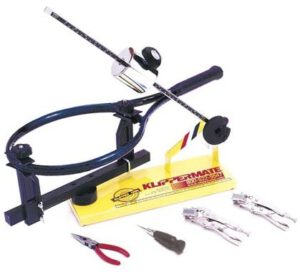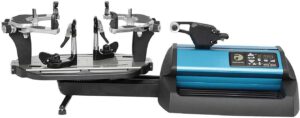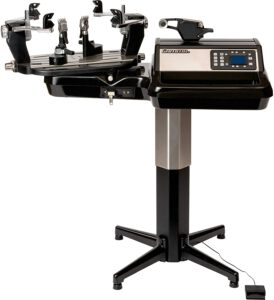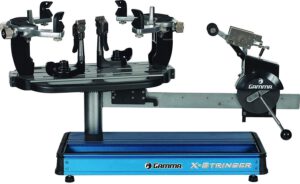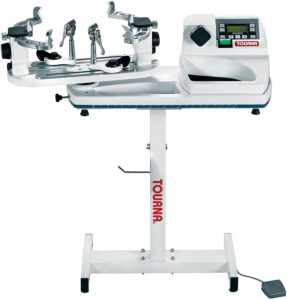For many tennis players, stringing your own racquets can seem like an intimidating chore. But other tennis players know from experience that there isn’t anything quite like using a custom-strung racquet that’s been tweaked and designed for your exact play style and needs.
Stringing your tennis racquet yourself can be a huge advantage on the court, it isn’t as difficult or time-consuming as you might think, but you do need to have a quality stringing machine.
While tennis racquet stringing machines are an investment, they’re well worth it for the money you’ll save over professional stringing services (not to mention the customization possible by doing it yourself). We’ve also included a few professional-level stringing machines that are perfect for existing tennis shops and new professionals who are just looking to get started.
Whether you’re just learning to string your racquet for the first time or are already an experienced professional, this list will include good stringing options for you.
Best Budget Stringing Machine
A great, no-fuss drop weight stringing machine which is perfect for someone who's just learning how to string a racquet or someone working within a smaller budget.
Check Today's PriceIf you’re looking for a good stringing machine to help you get started and learn the process, this is a good option. It’s also a go-to choice for a lot of home stringers who need a machine for themselves and friends and family, but who aren’t looking to string racquets professionally.
This is a drop-weight machine which means that stringing takes a little longer on average than other machines. However, and experienced stringer can still easily string a racquet in 30 minutes, and even first-time users are generally done in a little more than an hour.
In addition to being affordable and relatively easy to use, this stringer comes with all of the tools and accessories you’ll need. Klippermate also includes some free string which is a nice touch.
That way you can get stringing right away and don’t have to wait.
The stringing machine doesn’t need much setup and doesn’t need to be mounted to the table you’re working on to operate. Technical support is free, and the stringing machine comes with a lifetime warranty on the machine itself and its calibration.
However, this machine is slightly limited in that it’s only a 2-mount system. While it will hold your racquet securely in place, the grip isn’t quite as firm as some alternatives, and stringing the racquet will put a fair amount of pressure on those attachment points.
Best Drop Weight Stringing Machine
A great balance of quality and price for those not looking to make a large investment. A 6-point mounting system helps make this the best overall drop weight tennis stringing machine.
Check Today's PriceIf you’re looking for a slightly more advanced drop-weight system that takes some of the pressure off your racquet and makes stringing easier, the Gamma X-6 Tennis Racquet stringing machine is a great option.
Right off the bat, it improves on the standard drop weight design with a 6-point racquet mounting system instead of the standard 2 points. That gives you a lot more security and helps minimize the stress on any one section of the racquet.
Two composite floating clamps also give you the flexibility you need to adjust to the racquet hold and give yourself a little more room to work.
The swivel base also makes it easier to maneuver around the racquet while you work. That makes it a lot easier to be precise with your stringing, which in turn means that you have significantly more customization options.
The 9-90lbs range also gives you lots of flexibility with your tension, which is perfect for stringers who are ready to start experimenting with the best arrangement of tension and string for their racquet and play style.
This set includes a diamond-coated rotational racquet gripper, a pathfinder awl, straight awl, hex wrenches, and straight pliers with a cutter. That means that you basically have all the tools you need to string your racquet, though you may still want to use your own tools if you already have a kit.
Best Crank Tennis Stringing Machine
A great option for those not wanting to spend the money on an electric pull machine but who want more control than the drop weight machines offer.
Check Today's PriceOften considered a good alternative to drop weight stringing machines for those with good upper body strength, crank/lockout machines give you a lot of control over the whole process. That means that this Gamma X-ST Stringing Machine is a good option for people who want even more direct control and customization over their kit.
This machine uses a 6-point mounting system that’s perfect for holding even your best racquets in place without excess stress while you’re stringing. That also means it’s a good option for customizing your stringing since you don’t have to worry about the racquet over a longer stringing process.
The included toolset is also fairly comprehensive. You’ll get a pathfinder awl, straight awl, hex wrenches, pliers, and diagonal cutter in the box with the stringing machine. That’s a great deal if you’re just getting started, and a good supplement to your existing kit if you’re getting a new stringing machine or an upgrade.
The 360-degree turntable that comes standard as part of this machine is another boon. Especially with the manual crank, you don’t want to be working any harder than you have to. The turntable gives you easy access and makes the whole process much simpler.
It’s also nice to see a lighter stringing machine that still works just as well. Losing the drop weight on this machine makes it lighter and moderately more portable. That means it’s a good choice for coaches. It still weighs a pretty penny though.
Best Electronic Stringing Machine
Unless you're providing tennis stringing as a professional service, this constant pull stringing machine is a fantastic blend of cost and quality and should provide all you need.
Check Today's PriceIf you play a lot of tennis or have a large family that all play tennis, it may be worth investing in a more advanced machine that takes more of the time and work out of the stringing process.
This electronic constant pull machine might not be quite what we’d recommend for professional stringers, but it’s a great option if you do a lot of the stringing for friends and family. The electronic pull helps make sure you get consistent tension throughout the process.
This design is significantly faster than drop-weight stringing machines and much easier than manual crank machines.
This design is also more versatile than many.
If you’re looking to string tennis racquets, as well as racquets for racquetball, badminton, and more then this is a good option. The more adaptive design works well with the different configurations of each sports’ racquets so that you don’t need more than one machine for your family’s favorite hobbies.
This stringer is compatible with both 110 220V outlets, which means that it can be used in your home or with a higher voltage outlet in a professional shop.
This stringer also comes with a good 5-year limited warranty that covers pretty much everything but the grip points. If the machine fails, you’re protected and can get a repair or replacement as needed.
Best Budget Professional Tennis Stringing Machine
If you're buying for your pro shop and need a great stringing machine that doesn't cost an arm and a leg, this Tourna model is a good choice.
Check Today's PriceThis is a great machine…perhaps not quite as flashy or modern looking as the luxury machines, it’s still more than enough to get your business or service started on a good foot.
The quick-mount system is self-leveling, which can be a huge advantage in a busy shop environment. You know that the stringing machine is taking care of that important detail, which lets you get to work that much faster.
It also gives you control over the pull rate, from slow to fast, so you can adjust its action to your needs and skill level. Perfect for shops with experienced employees and stringers who are still learning the ropes.
The stand is also a huge advantage of this system. Sturdy enough that you don’t need to brace the stand against a table or wall, it’s also height adjustable. The caster wheels are great for moving the whole machine through your shop, so you can adjust your workspace day by day as needed.
This system also uses constant pull tensioning, which gives you truer tension than other systems since it automatically adjusts as the string begins to stretch and settle into the new configuration.
Extremely sensitive computer monitoring helps ensure that your tension is always exactly where you want it and can help you adjust as you create custom configurations.
Best Stringing Machine for Pros
Top of the line option for pro shops and professional players. This model is widely considered to be the best of the best and you'll know it from the price tag.
Check Today's PriceThis stringing machine is a fantastic option if you’re looking for something that gets the job done well and looks great doing it. It’s a good choice for bigger tennis shops and repair outfits and may even be a good choice in a tennis club or community recreation setting.
It’s more modern design and sleek black colors ensure that this machine will have pride of place and will give your customers confidence that you know what you’re doing and are willing to invest in the best possible equipment.
W/LCD screen makes the entire stringing process easy to understand and control, which makes training new stringers much easier as well as saving experienced users a ton of time.
The self-centering mounting system also helps to prevent racquet stress by making sure the racquet is appropriately positioned for stringing. That means less chance of long-term stress and a longer life for all the racquets you string.
This system is also one of the most complete offerings on the market with a wide range of critical stringing tools included right in the box, including the all-important starting clamp for the best possible tensioning.
Why You Should String Your Own Racquet
Stringing your racquet can seem like a lot to ask from new tennis players, so we wanted to take a moment to acknowledge why developing this skill can make a huge difference and you get more invested in the game.
For one thing, stringing your own racquet saves money in the long term. Many tennis players need their racquets re-strung every month. That can be $300-$500 dollars in fees for professional stringing services every year.
Comparatively, the strings themselves usually cost less than half a full professional stringing service. Restringing your racquet just as often as before brings the annual cost per-racquet down to only about $100 per year if you do the stringing yourself.
But the cost isn’t always the main reason people switch to stringing their racquets themselves.
Often, it’s all about getting the customized and optimized performance you just can’t get from a standard professional stringing service.
Once you’re stringing your racquet, it’s much easier to experiment with different kinds of strings, different levels of tension, and other details to improve your performance as a player. Stringing yourself can also help you determine when your racquet needs new strings, reducing the chances of poor performance during an important match.
Stringing yourself is just a great way to take your tennis game to the next level and make the sport more accessible and affordable in the long term.
How to Pick a Tennis Racquet Stringing Machine
There are a lot of different models of stringing machines out there, so it’s important to know what kind of machine is the best fit for you.
Cost
Stringing machines start as low as $200 for a drop weight machine. These have fewer adaptations so it takes a little longer to string your racquet, but they are the most cost-effective option.
From that low starting price you can spend almost however much you would like on a stringing machine. More expensive professional electric models can run for as much as $5,000 or more, and there are models of stringing machines at every price point in between.
Most home users are best served by a machine that costs $500 or less, especially if there are only 1-2 tennis players in the house. However, the more racquets you need to string, the easier it is to accept a higher price since you’ll quickly make that money back in lowered maintenance costs.
Professionals should look for machines starting in the $1,000 range and up since those machines are usually more efficient and faster. Faster stringing means higher profits for your business.
Tabletop vs Standalone
Tabletop stringing machines are usually the go-to option for home-use since they are smaller, easier to store, and easier to maintain.
However, standalone models are often better for stores, coaches, and even club use since they don’t need any additional furniture and are usually the sturdier and easier to use standing.
Drop Weight vs Crank/Lockout vs Electronic Constant Pull
Drop weight stringing machines are a little finicky and have a higher learning curve than electric, but they are very precise and work well for most people. It takes a little longer to string your racquet with these machines, but practice will improve your turnaround time.
Drop weight machines are also the most affordable of the three.
Crank Lockout machines are a good option if you want something a little easier to use than a drop weight machine from a technical standpoint, but they also require more upper body strength and are a more physical kind of machine to use. Pricewise these a middle ground machine, but they also offer a lot of control and customization for your racquet.
Finally, there are electric constant pull machines that are commonly used by professional stringers thanks to their high efficiency and precision. Because these machines adjust the tension on the string as it stretches, these machines can help even novice stringers get a perfectly tensioned string.
Floating Vs Fixed Swivel Clamps
Floating clamps are generally considered slightly weaker/less stable than fixed swivel clamps because they aren’t directly grounded. However, both designs work well, it’s just a matter of finding a configuration that works for you.
That said, fixed swivel clamps do seem to work better for anyone new to racquet stringing.
2 vs 4 vs 6 Mounts
All three of these mount configurations are common, with 6 mounts being the most secure and 2 mounts being the least.
The more mounts you have the higher the cost of the machine is likely to be. However, it’s easier to level and center your racquet with 6 mounts instead of 2, or even 4.
2 mounts do work, but you have to be very precise and there are a few more steps involved to make sure your racquet is positioned properly before you start stringing.
FAQ
How Difficult Is It to String a Tennis Racquet?
Stringing isn’t very difficult to learn, but it can be difficult to master. Be prepared for a slight learning curve when you get started, and incremental improvements in your stringing technique for at least a year after you get started.
How Long Does it Take to String a Tennis Racquet?
Once you’re experienced it can take half an hour or less to string a customized racquet. However, the first time you attempt the job you should plan on 1-2 hours so you can take your time and pay attention to the whole process.
How Do I Learn to String a Tennis Racquet?
Learning is simple, you can watch a few videos, learn from someone else, or read a tutorial. Here are some basics to get you started.
- Measure 35-40 feet of string. (You’ll likely use about 38ft) Start with more than you’ll need as a beginner.
- Use a sharp knife to remove the old string from the racquet.
- Inspect any rubber grommets for signs of wear and tear
- Mount the racquet on the stringing machine, every machine is a little different, so follow its instructions.
- Choose between a 1-string pattern or a 2-string pattern.
- Pull the main strings (which run parallel to the longest point of the racquet.) Knot them when they are tensioned and in place.
- String the cross strings after the mains. Weave the string through the mains, and tension as you go. Use the same amount of tension as the main strings. Knot each string as you go.
These are basic instructions, but you can also alter the tension, experiment with different string materials, and make other customizations to your racquet as you get more experienced with stringing.
How Do I Calibrate a Tennis Stringing Machine?
Every machine will have a slightly different calibration process, but check calibration is simple. Just clamp a string into the machine (it doesn’t have to be run through a racquet to check calibration), attach it to a calibration checker or scale, and then tension the string. The tension the calibrator reports and the tension the machine shows should be the same. If not, follow the instructions provided with your machine to re-calibrate so that the calibrator and the machine agree.
Usually, it’s a good idea to relax the tension and test it again.

